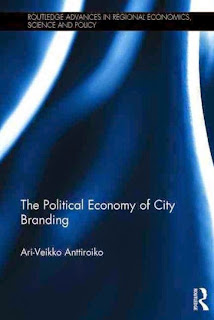What’s the use of city rankings?
City rankings disclose strategic information about cities.
Due to the nature of rankings, they inherently encourage people to take a
relational and competitive view of cities, which contributes to the knowledge
base of local economic policy. However, such a view is hampered by poor
methodology and the generalist approach typical of many rankings. Especially
when they use multiple criteria, this dramatically affects the overall scores
and ranking order. In a similar way, finding ‘the best’ or ‘most attractive’
city in general terms may be relevant for high calibre global cities, but such
a setting does not reveal much for assessing the role of more specialized
middle-sized cities in the lower ranks. It is also difficult to determine how
different aspects of ranking should be weighted. If Tokyo is a top city in global corporate
headquarters, it may be on the problem side in terms of the cost of housing or
living in general. If Helsinki
is ranked innovative, it suffers from small scale, remoteness and a challenging
climate. Mumbai may be one of the global leaders in attracting offshoring
activities, but hygiene, health and infrastructure considerations put it
definitively down in multi-criteria-based rankings. Combining a wide range of
indicators tends to neutralize rankings, for global cities with multiple
strengths will naturally stand out. The Economist Intelligence Unit’s (2012)
benchmarking of global city competitiveness, PricewaterhouseCoopers’ Cities
of Opportunity (PwC 2012) and MasterCard’s Worldwide Centers of Commerce
Index (MasterCard Worldwide 2008) are good examples of such rankings. Their
positive impact on local economic policy is, however, that they encourage
policymakers and developers to look beyond narrow-minded economic indicators,
implying that it is not only the number of headquarters, patents or skilled
workers that count in global intercity competition and overall competitiveness,
which is certainly true.
This creates an interesting methodological dilemma. ‘The
World’s Best’ type of rankings become like a global city lottery, in which
lower-rank global cities show up only randomly, depending on sampling and
criteria. The problem becomes more obvious with the category of middle-sized
cities, “which cannot compete in all fields of economic activity but have to
focus on selected branches. This strategy of specialization is based on an
accurate examination of existing economic, social and environmental potentials
in order to find specific niches in which the city is able to establish some
competitive advantage. For that reason, it does not really make sense to
compare medium-sized cities generally and to evaluate their attractiveness in
total.” (Giffinger et al. 2010: 303).
At the same time, rankings that are methodologically
sophisticated enough have a strategic role to play as they are a powerful
competitive instrument working on the basis of differences. This enables cities
to find their position in the global urban hierarchy and economic division of
labour, to sharpen their profiles and to initiate local learning processes
(Giffinger et al. 2010: 310). In practice, such processes are largely
affected by mediatized political economy, which leads to complex knowledge
processes in which businesses, media, public managers, politicians and citizens
interact. A simple expression of an impulse that ranking may give is the
headline of a news item in Yahoo! Finance, India, published on the basis of a
city ranking, ‘Mumbai among worst cities for intellectual capital and
innovation: study’, or the one in Forbes in February 2013, ‘Detroit tops
2013 list of America’s most miserable cities’. Sometimes the results are used
for promotional purposes too, as in the feature story in the investment portal
of the City of Stockholm, entitled ‘Top ranking for Stockholm in prestigious
report’, with a leader ‘The PWC ranking “Cities of Opportunity 2011” puts
Stockholm at number four, together with New York, Toronto and San Francisco.
It's the highest ranking city in Europe.’
Actually many large cities have started to publicize rankings in their economic
development websites to substantiate the facts of their assets and performance,
as in the website of the Economic Development Board of Singapore
(https://www.edb.gov.sg/content/edb/en/why-singapore/about-singapore/facts-and-rankings/rankings.html).
In such cases, rankings are powerful tools to convey a message of
competitiveness, as the results are based on analyses and comparisons made by
an independent party. Information on a city’s high position in different
rankings gives an impression that the city really is a good place for business,
belongs to the rank of global hubs, or is a member of a top league of creative
cities or whatever is the message promoted by the city and supported by rankings.
In addition, rankings serve many times as impulses for even leading cities to
start the hard branding process, as was the case with Amsterdam in the first
half of the 2000s (Gemeente Amsterdam 2004) or Sydney in the latter half of the
2000s (Parmenter 2011).
This discussion is
an excerpt from The Political Economy of City Branding by A.-V. Anttiroiko
(Routledge, 2014, pp. 137-139).
References
Economist Intelligence Unit (2012) Hot spots.
Benchmarking global city competitiveness. A report from the Economist
Intelligence Unit. The Economist.
Gemeente Amsterdam (2004) The Making of … the city
marketing of Amsterdam.
Het ontstaan van de city marketing van Amsterdam. I amsterdam. Amsterdam:
Gemeente Amsterdam (City of Amsterdam).
Giffinger, Rudolf and Haindlmaier, Gudrun and Kramar, Hans
(2010) The role of rankings in growing city competition. Urban Research and
Practice, 3(3), 299-312.
MasterCard Worldwide (2008) Worldwide Centers of
Commerce Index 2008. Insights. MasterCard Worldwide. Retrieved May 15,
2013, from
http://www.mastercard.com/us/company/en/insights/pdfs/2008/MCWW_WCoC-Report_2008.pdf
Parmenter, Geoff (2011) The City Branding of Sydney. In: Keith Dinnie
(Ed.) City Branding: Theory and Cases, pp. 199-205. Basingstoke:
Palgrave Macmillan.
PwC (2012) Cities of Opportunity.
PricewaterhouseCoopers. Partnership for New
York City. Retrieved May 12, 2013, from
http://www.pwc.com/us/en/cities-of-opportunity/assets/cities-opp-2012.pdf

Ei kommentteja:
Lähetä kommentti